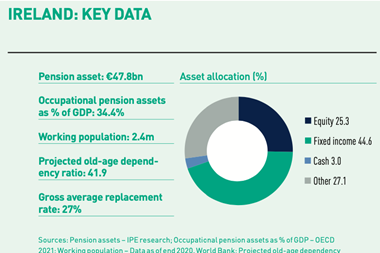Ireland’s Pensions Authority has published a revised code of practice for occupational pension scheme trustees, with one observer calling for more guidance on how trustees should implement and document risk management processes.
The new code follows the transposition of IORP II into Irish law in April 2021. It is broadly similar to the draft published last July, although a number of concerns on specific issues raised in the 38 submissions to the consultation have resulted in some changes.
The new code covers governance, administration, internal control, investment, defined benefit (DB) financial management and fit and proper requirements. There is also a new chapter on master trusts which includes conflicts of interest and trustee independence, continuity planning and capital adequacy.
Within the investment rules, there is now less emphasis on statements regarding quantitative and qualitative assessments and more focus on the governance aspects of the investment process.
Trustees must have a written statement outlining the governance process, under which investment objectives and strategy will be decided on and implemented. They must take into account this “statement of investment governance” when appointing or reviewing any investment service provider, or when making decisions in relation to the investment of the scheme’s assets. The statement is separate from the statement of investment policy principles (SIPP).
For DB schemes, the statement of investment governance must define the process for reaching agreement on investment objectives and investment strategy.
This also includes level of risk tolerance; whether environmental, social and governance factors will be considered; and the information to be considered when assessing investment performance. There are similar rules for defined contribution (DC) schemes in relation to the choices offered to members.
“There is little detail in the code as to how schemes should approach their investment strategy to improve their funding level and move towards their ‘endgame’ objective”
Thomas Donohoe, investment director Insight Europe, Insight Investment
In appointing investment managers, the trustees must consider conflicts of interest which may arise for their advisers when the latter are asked to advise on these appointments.
In terms of DB financial management, trustees must conduct asset and liability assessments often enough to keep abreast of funding issues. They must also have a good understanding of projected cash flows and discounted liability values.
DB financial risk assessment tool
The Pensions Authority has also launched a DB financial risk assessment tool. This must be used to measure and manage financial risks within DB schemes.
The risk measure is a quantitative estimate of the ability of a DB scheme to absorb financial shocks. It provides an estimate of the likelihood that the scheme will meet its funding standard and funding standard reserve obligations, and therefore not require supplemental financial support from the sponsoring employer over a one-year time horizon.
A spreadsheet is available on the PA website to help schemes carry out the calculations.
But in spite of some changes to the draft code in response to submissions from the pensions sector, there are still some concerns about the revised code.
“With many schemes having low funding levels, there is little detail in the code as to how schemes should approach their investment strategy to improve their funding level and move towards their ‘endgame’ objective,” said Thomas Donohoe, investment director Insight Europe, Insight Investment. “As there is no industry pension safety net – such as the Pension Protection Fund in the UK – this compounds the problem.”
He observed that since the financial crisis of 2008, pension funds – which he said suffered worse deficits on average than their European counterparts – have successfully increased their investment exposure to higher risk instruments in order to reduce those deficits. But, he warned, given high global asset valuations and a possible change in tack from global central banks after years of very easy monetary policy, that approach needs to change.
He added: “Risk management is at the core of the revised code. The Pensions Authority have said that trustees need to implement and document risk management processes, but have not provided guidance on how to do that.”
And he concluded: “We think they need to be more explicit and provide more guidance to trustees on how to manage risks to ensure better outcomes for pension scheme members. In the absence of guidance from the Pensions Authority, trustees will need to work closely with their advisers and investment managers to set an appropriate investment strategy and risk management process.”









No comments yet